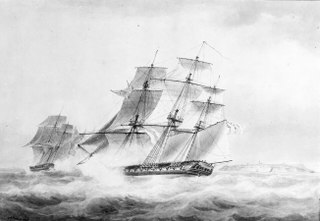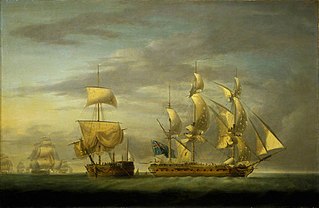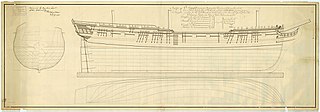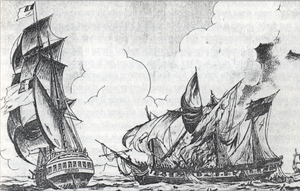
HMS Speedy was a 14-gun Speedy-class brig of the British Royal Navy. Built during the last years of the American War of Independence, she served with distinction during the French Revolutionary Wars.

HMS Hannibal was a 74-gun third-rate ship of the line of the Royal Navy, launched on 15 April 1786, named after the Carthaginian general Hannibal. She is best known for having taken part in the Algeciras Campaign, and for having run aground during the First Battle of Algeciras on 5 July 1801, which resulted in her capture. She then served in the French Navy until she was broken up in 1824.

HMS Latona was a 36-gun, fifth-rate frigate of the Royal Navy that served during the American Revolutionary War, the French Revolutionary Wars, and the Napoleonic Wars. Shortly after her launch in 1781, she participated in the Battle of Dogger Bank against a Dutch squadron in the North Sea. In September 1782, Latona took part in the relief of Gibraltar and was the first ship in the convoy to pass through the Straits, when Richard Howe sent her ahead, to spy on the condition of the Franco-Spanish fleet in Algeciras Bay.
HMS Spencer was a 74-gun third-rate ship of the line of the Royal Navy, launched on 10 May 1800 at Bucklers Hard. Her designer was the French émigré shipwright Jean-Louis Barrallier. She served in two major battles, Algeciras Bay and San Domingo, and in a number of other campaigns. She was broken up in 1822.

Révolutionnaire, was a 40-gun Seine-class frigate of the French Navy, launched in May 1794. The British captured her in October 1794 and she went on to serve with the Royal Navy until she was broken up in 1822. During this service Revolutionnaire took part in numerous actions, including three for which the Admiralty would in 1847 award clasps to the Naval General Service Medal, and captured several privateers and merchant vessels.

HMS Phoenix was a 36-gun Perseverance-class fifth-rate frigate of the Royal Navy. The shipbuilder George Parsons built her at Bursledon and launched her on 15 July 1783. She served in the French Revolutionary and Napoleonic Wars and was instrumental in the events leading up to the battle of Trafalgar. Phoenix was involved in several single-ship actions, the most notable occurring on 10 August 1805 when she captured the French frigate Didon, which was more heavily armed than her. She was wrecked, without loss of life, off Smyrna in 1816.

America was a Téméraire-class 74-gun ship of the line of the French Navy. The Royal Navy captured her in 1794 at the Battle of the Glorious First of June. She then served with the British under the name HMS Impetueux until she was broken up in 1813. She became the prototype for the Royal Navy America-class ship of the line.

HMS Santa Margarita was a 36-gun fifth-rate frigate of the Royal Navy. She had been built for service with the Spanish Navy, but was captured after five years in service, eventually spending nearly 60 years with the British.

HMS Mercury was a 28-gun Enterprise-class sixth-rate frigate of the Royal Navy. She was built during the American War of Independence and serving during the later years of that conflict. She continued to serve during the years of peace and had an active career during the French Revolutionary Wars and most of the Napoleonic Wars, until being broken up in 1814.
HMS Eurydice was a 24-gun Porcupine-class post ship of the Royal Navy built in 1781 and broken up in 1834. During her long career she saw service in the American War of Independence, the French Revolutionary Wars and the Napoleonic Wars. She captured a number of enemy privateers and served in the East and West Indies, the Mediterranean and British and American waters.

HMS Castor was a 32-gun Amazon-class fifth-rate frigate of the Royal Navy. She served during the French Revolutionary and Napoleonic Wars. The French briefly captured her during the Atlantic Campaign of May 1794 but she spent just 20 days in French hands as a British ship retook her before her prize crew could reach a French port. Castor eventually saw service in many of the theatres of the wars, spending time in the waters off the British Isles, in the Mediterranean and Atlantic, as well as the Caribbean.

HMS Lowestoffe was a 32-gun fifth-rate frigate of the Royal Navy. Built during the latter part of the Seven Years' War, she went on to see action in the American War of Independence and the French Revolutionary War, and served often in the Caribbean. A young Horatio Nelson served aboard her shortly after passing his lieutenant's examination.

HMS Unicorn was a 32-gun fifth-rate Pallas-class frigate of the Royal Navy, launched in 1794 at Chatham. This frigate served in both the French Revolutionary Wars and the Napoleonic Wars, including a medal action early in her career. She was broken up in 1815.

HMS Cleopatra was a 32-gun Amazon-class fifth-rate frigate of the Royal Navy. She had a long career, seeing service during the Fourth Anglo-Dutch War, and the French Revolutionary and Napoleonic Wars. During the latter wars she fought two notable engagements with larger French opponents. In the first engagement she was forced to surrender, but succeeded in damaging the French ship so badly that she was captured several days later, while Cleopatra was retaken. In the second she forced the surrender of a 40-gun frigate. After serving under several notable commanders she was broken up towards the end of the Napoleonic Wars.

HMS Venus was the name ship of the 36-gun Venus-class fifth-rate frigates of the Royal Navy. She was launched in 1758 and served for more than half a century until 1809. She was reduced from 36 to 32 guns in 1792. She was sold in 1822.
The 16-gun French Mutine-class corvette Aurore was launched in 1799. The British frigate HMS Thames captured her in 1801; she was commissioned into the Royal Navy in 1803 and named HMS Charwell. Charwell served in the Channel, South Atlantic, and Indian Ocean. She was laid up in 1810 and sold in 1813.
HMS Incendiary was an 8-gun fireship of the Royal Navy. She was present at a number of major battles during the French Revolutionary Wars, and captured, or participated in the capture, of several armed vessels. In January 1801 she was in the Gulf of Cadiz where she encountered Admiral Ganteume's squadron. The 80-gun French Navy ship of the line Indivisible received the credit for the actual capture.
Salamine was originally the Spanish Navy's Infante 18-gun brig, built in 1787 at Cadiz. The French Navy captured her at Toulon in December 1793 and recommissioned her; they renamed her on 10 May 1798 as Salamine, for the battle of Salamis. On 18 June 1799, HMS Emerald captured her and she was brought into Royal Navy service as HMS Salamine. She served briefly in the Mediterranean, where she captured two French privateers and several merchant vessels before the Royal Navy sold her at Malta in 1802, after the Treaty of Amiens ended the war with France.

The Atlantic raid of June 1796 was a short campaign containing three connected minor naval engagements fought in the Western Approaches comprising Royal Navy efforts to eliminate a squadron of French frigates operating against British commerce during the French Revolutionary Wars. Although Royal Navy dominance in the Western Atlantic had been established, French commerce raiders operating on short cruises were having a damaging effect on British trade, and British frigate squadrons regularly patrolled from Cork in search of the raiders. One such squadron comprised the 36-gun frigates HMS Unicorn and HMS Santa Margarita, patrolling in the vicinity of the Scilly Isles, which encountered a French squadron comprising the frigates Tribune and Tamise and the corvette Légėre.
HMS Imogen was the French privateer Diable á Quatre, built at Bordeaux in 1792, that Thames and Immortalite captured in 1800. The Royal Navy took her into service in 1801 as HMS Imogen. She foundered in 1805.
















